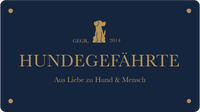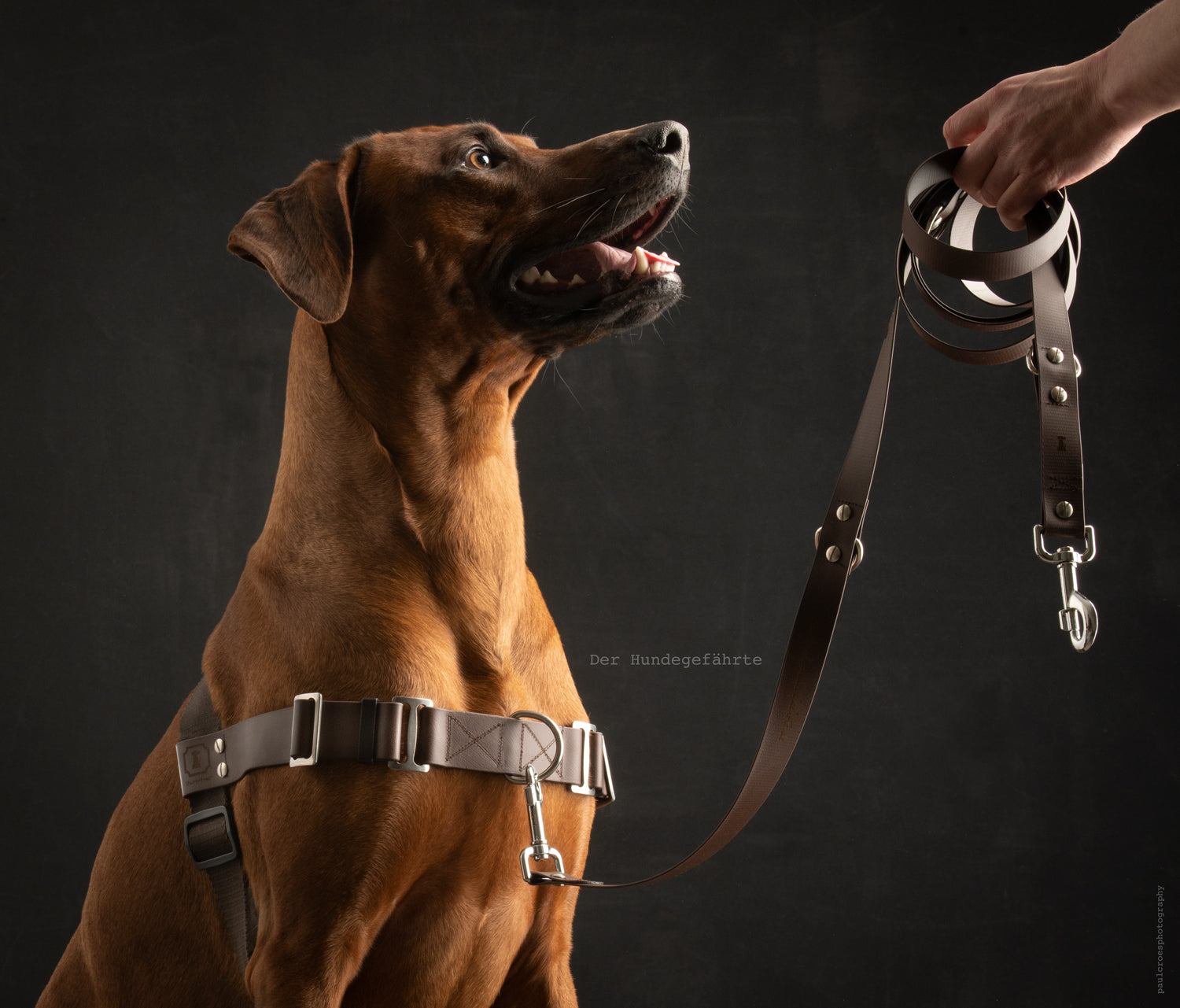Set STURMFREI®
Here you can register and watch the videos and read the explanations at your leisure.
To the dog companion community.
To optimally adjust STURMFREI® (Saver), pull the harness over the dog's head (buckle is under the stomach). The lead ring (D-ring or square ring) lies on the front of the "decolleté", the climbing carabiner for passing the leash through on the back.
If you put the harness over the dog's head and sit next to the dog at the same height instead of in front of the dog, it will be more comfortable for the dog.


Pull the harness over the dog's head when he is standing. Close the harness under your stomach and assess whether it is too big or too small. You can determine the smallest setting for your dog as follows:
Insert the buckle into the closer and let the dog sit down. Now feel under his chest (where the closer is) whether the material is pressing firmly against his chest. If so, loosen the waist belt by lengthening it.
STURMFREI® Saver: First, only deal with the front abdominal belt. You can adjust the back waist belt when the front part is fully adjusted.
The anti-stress harness STURMFREI® is the only front harness whose front strap can be individually adjusted in height.
To ensure that the front strap does not hinder the dog when walking and does not press against the soft tissues of the neck when pulled, position it at the top of the shoulder blades. You can find these by feeling your dog.
You can adjust the length of the strap on the left and right. The closer the stainless steel slider is to the screw, the shorter the front strap.



When your dog is standing, the front strap lies loosely on the front chest. If he sits, then
1. The abdominal belt (bottom) does not press firmly against the lower chest.
2. you can slide a finger between the armpit and the waist belt. The waist belt does not curve forward into the armpit.
There are at least three black sliders (one XXS) on the waist belt. Slide the sliders closest to the front belt over the front belt to give it additional stability. The third slider is pushed towards the closer to prevent the waist belt from forming loops.
The STURMFREI® Saver has several plastic sliders on both waist straps. The purpose of the additional sliders is that after adjusting the front abdominal belt, the front belt and the rear abdominal belt, you can optimally position the elements that connect the two abdominal belts depending on the length adjustment of the belts.
If your dog tends to escape, position the front strap over the shoulder blades (but under the larynx area). There you can adjust the front strap a little tighter than on your shoulders and be more confident when training outside. The safer you feel, lower the belt so that you benefit from the braking at shoulder height (deflection).
You can remove the rear waist belt and lower connector if necessary.



Due to production reasons, specimens may differ externally from the dishes presented in the video.
Every dog's chest is different, some pointed, some flat, some oval-shaped. The front strap looks looser on one dog than on another, also depending on the length of the coat.
FAQs
Yes, you can find the video here .
Yes, you can find it further down on this page or watch it on YouTube .
Yes, depending on the abdominal circumference, the slider is located further to the left (larger abdominal circumference) or to the right (smaller abdominal circumference). Pull the leash through the carabiner at the back and let it pass to the right or left of the dog's neck, depending on how the pressure of tension on the leash affects the position.
No, he doesn't have to. However, it has two advantages:
1. As with us humans, the reaction to “slow down” is most instinctive when pressure is applied to the shoulder from the front. (To do this, spontaneously press against your shoulder and you will feel it go backwards instead of in the opposite direction).
2. The shoulder is not a “threatening” place for the dog. This means: If he feels pressure on his shoulder, it doesn't trigger a feeling of strong threat (as is the case with the collar). This means: It is less stressful for the dog to be slowed down at the shoulder than in the area above and he is more likely to react to braking at the shoulder by stopping (instead of fleeing, aggression/resistance).
Yes, pull longer lines through the carabiner at the back and attach the line carabiner at the front. However, it is advisable to use a shorter leash for the first few walks, as the tension on the leash will direct the angle upwards and not to the left (if you are walking on the left).
It is good for the dog's learning effect that he is initially braked horizontally from right to left so that he realizes this and does not have to exert strong pressure.
Yes, the earlier a dog gets to know how to lead as naturally as possible, the fewer problems arise later. By turning towards you, the dog also learns to orientate itself more towards you later when free running (frequent eye contact). But please also consider: Dogs, like children, learn through experiences with the environment. They want to interact, sniff, walk, and learn to assess themselves and others. It is therefore very important to give the dog these experiences.
With the STURMFREI®, contact with other dogs on a leash is also possible by not tightening the neck (collar) or throwing it back (chest harness). This will help you avoid leash aggression in the long term.
Two sliders serve to additionally stabilize the front strap (position underneath on the left and right, not available for size XXS). One is used to press the two straps lying on top of each other together on the closer. So that no loop is created that disturbs the dog while running.
The additional sliders on the STURMFREI® Saver are used to place the two connecting elements that connect the abdominal straps where they least disturb the dog after all the straps have been adjusted.
Yes, if you switch to a collar or chest harness, he will be guided differently and will react accordingly in the long term with corresponding reactions. But this changes with age, for example (as it does with us humans). Because of the loss of physical strength, the dog pulls forward less. Most dogs fall asleep with the STURMFREI® in their basket.
You feel less constricted than with standard wider chest harnesses with more material.
In the very small harnesses, square rings are sometimes used because the construction that holds the D-ring and the D-ring itself are heavier (since particularly thick BioThane® is used to provide stability against the friction of the D-ring). Since this could bother small dogs, we use a lightweight square ring instead.
If your dog constantly has his nose to the ground and is flat on his sides, check the front harness. When you bend forward, the abdominal belt will slide forward if it is not adjusted tight enough.
For example, if you attach the dog to something where it should wait, or you just want to go to the car, you can also attach the leash directly to the stainless steel slider at the back. This is slightly larger than the sliders on the front strap because the carabiner for pulling the leash through is hooked into one side. Use the free side for briefly attaching the dog.
However, if you lead the dog over a longer distance at the back of the stainless steel slider, you will be faced with the same problem as with chest harnesses: guiding from behind provokes the dog to pull forward/stimulus focusing in the front vision/smell area.
Yes. If you want your dog NOT to pull. When riding a bike, generally make sure that your dog has enough leash (doesn't run too close to the spokes and could fall behind). Please also note: Other dogs can react aggressively to a dog sprinting past them, as in nature they do not tolerate - from their point of view - being "ambushed" out of nowhere (especially if they have nervous people with them) .
Therefore, with your dog on a leash, only drive on routes where it is compulsory to be on a leash or slow down and give the dog a large leash radius so that he and the other dogs can determine through interaction with each other that there is no danger.
Our production is standardized. Unfortunately, individual changes are not possible.
All texts and content are written by Nina Bednarz (Communication Sciences, Sociology MA) and arise from her accumulated specialist knowledge.
The content is based on specialist knowledge of mammalian learning behavior, interaction and communication rituals, which follow similar structures across species.
There is currently no book in the dog area that deals with these connections.
Any reproduction of the content must be marked with regard to copyright. Failure to provide a source will result in legal action.
Sources should be marked as follows:
Nina Bednarz (Communication Science, Sociology MA), The Dog Companion, www.der-hundegefaehrunge.de
Online seminars are being planned for 2023.
Our customers benefit from experience reports. Every dog, every owner, every attitude is different. It is very helpful for interested parties to find out in as much detail as possible what has changed as a result of STURMFREI® and how the dog behaved beforehand. Solving health problems by reducing the stress of leading the way is also an interesting aspect.
Cases in which particularly insecure dogs have been resocialized with STURMFREI® over months are also encouraging and interesting for people who are looking for solutions.
STURMFREI® has been patented since 2014 and is protected in Germany, England, Ireland, France, Spain, Italy, Lichtenstein, Austria, Poland and Switzerland. The STURMFREI® brand is also under protection.
STURMFREI® was constructed and is explained by Nina Bednarz (Communication Sciences, Sociology MA)
STURMFREI® is protected by the EU trademark EUTM 013790241 registered with the European Union Intellectual Property Office (EUIPO) and by the European patent EP 3 209 120.
Video zum Einstellen und Anpassen
Setting & Adjustment
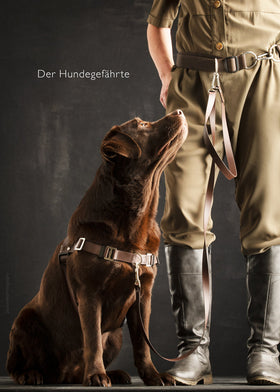
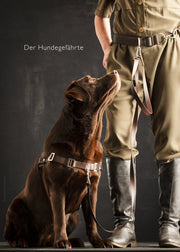
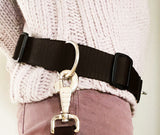
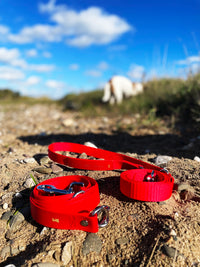
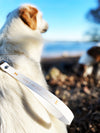
Relief
Belly belt CHILL
Guide your dog using a holder on the waist belt. Your dog orientates itself through the tension of the body and is therefore less exposed to irritation caused by changing the tension of the leash due to the arm swinging around.
